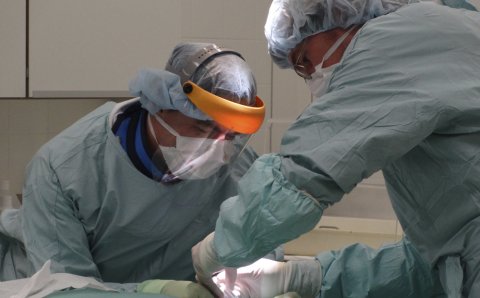Radioactive globules now used to treat head and throat tumours
Alpe d’Huez/KWF has granted researchers at UMC Utrecht almost 300,000 Euros for an innovative cancer treatment developed in collaboration with the Faculty of Veterinary Medicine. This treatment involves injecting radioactive globules into tumours for extremely precise local irradiation.
Injecting radioactive globules directly into a tumour may be a treatment option for tumours that cannot easily be surgically removed. That was the idea by medical biologist Dr. Frank Nijsen, orthognathic surgeon Dr. Robert van Es and nuclear medicine specialist Dr. Marnix Lam from UMC Utrecht. They worked together with Dr. Bas van Nimwegen of the University Clinic for Companion Animal Health in order to treat tumours of the head and throat using radioactive globules.
Dogs and cats
The treatment is based on radioactive globules of holmium (microspheres) which are visible on MRI, CT and nuclear scans. This technique was first applied at the Companion Animal Health Clinic by the former Professor of Surgery Dr. Jolle Kirpensteijn, in cooperation with Dr. Frank Nijsen and Dr. Bas van Nimwegen. The preliminary results are very promising. Over the past four years, 15 cats and dogs with aggressive tumours of the tongue have received the treatment.

The treatment was effective in the majority of the animals. On average, the tumour was reduced by 80% and the tongue retained its functionality. The researchers expect that humans will also benefit from the new holmium therapy. “The results in these animal patients are very promising”, explains Prof. Ron Koole of the Department of Oral and Maxillofacial Surgery at UMC Utrecht. “That is why I brought together the people working on this to try to make the treatment available for human patients.”
Better control
With video-controlled injection, the globules are injected very accurately into the proper location in the tumour. The holmium globules emit 90% of their radiation into the first three millimetres of the tumour tissue. This means that the radiation dose in the tumour can be very high without damaging the surrounding tissue.
With the subsidy granted by Alpe d’ Huez/KWF, the researchers in Utrecht will build on their findings, in which the research at Companion Animal Health will continue to play a role as a model for the treatment of humans. It should lead to a phase-I clinical trial to study the safety aspects of treating human patients. One of the most important issues is how the globules can be injected in such a way that they are properly distributed within the tumour. Any potential side effects will also have to be identified.

Future joint research
“Of course, tumours of the head and throat are just one application for this treatment method”, explains Dr. Frank Nijsen from UMC Utrecht. “In principle, it should be possible to treat any tumour with holmium globules, as long as it can be reached by a needle. But first we will have to prove that we can inject tumours consistently and in a controlled manner.”
Dr. Bas van Nimwegen is already studying the treatment of tumours of the head and throat in companion animals in cooperation with Dr. Frank Nijsen (UMCU) as part of the ‘Advances in Veterinary Research’ (AVR) research line under the supervision of Prof. Jan Willem Hesselink (UKG). In addition to being patients, the animals that receive the treatment also serve as a model for humans with comparable tumours. In addition to treating a wide range of tumours, the project’s emphasis lies on improving the treatment method using imaging technologies (MRI and CT) and using them to improve the dosage of the radioactive globules in the tumour by determining the amount of radiation that reaches the tumour.

